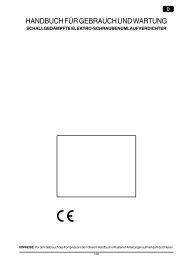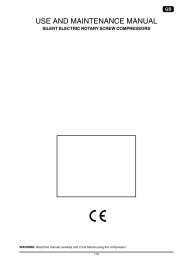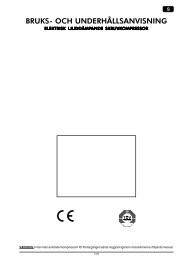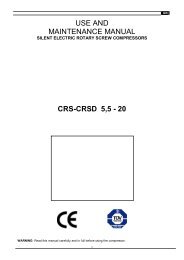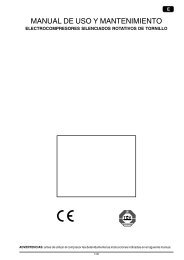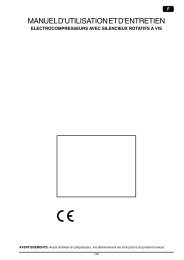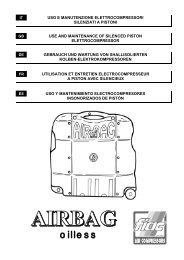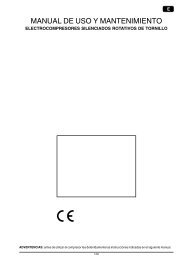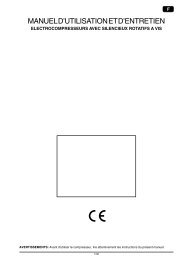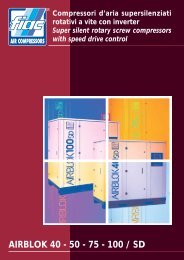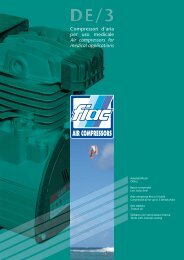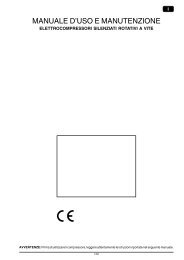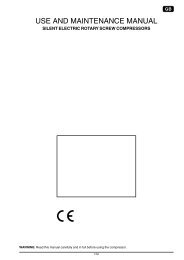GM - TR - VX - AB - CCS
GM - TR - VX - AB - CCS
GM - TR - VX - AB - CCS
Create successful ePaper yourself
Turn your PDF publications into a flip-book with our unique Google optimized e-Paper software.
19 GBdampened with soapy water and dry thoroughly.22. USE ONLY GENUINE REPLACEMENT PARTSReplacement parts not original may void your warranty and can leadto malfunction and resulting injuries. Genuine parts are availablefrom your dealer.23. DO NOT MODIFY THE COMPRESSORDo not modify the compressor. Always contact the authorized servicecenter any repairs. Unauthorized modification may not only impairthe compressor performance but may also result in accident or injuryto repair personnel who do not have the required knowledge andtechnical expertise to perform the repair operations correctly.24. TURN OFF THE PRESSURE SWITCH WHEN THE COMPRESSORIS NOT USEDWhen the compressor is not used, turn the knob of the pressureswitch OFF, disconnect it from the power source and open the draincock to discharge the compressed air from the air tank.25. NEVER TOUCH HOT SURFACETo reduce the risk of burns, do not touch tubes, heads, cylinder andmotors.26. DO NOT DIRECT AIR S<strong>TR</strong>EAM AT BODYRisk of injury, do not direct air stream at persons or animals.27. DRAIN TANKDrain tank daily or after 4 hours of use.Open drain fitting and tilt compressor to empty accumulated water.28. DO NOT STOP COMPRESSOR BY PULLING OUT THE PLUGUse the “AUTO/OFF” knob of pressure switch.29. USE ONLY RECOMMENDED AIR HANDLING PARTSACCEPT<strong>AB</strong>LE FOR PRESSURE NOT LESS THAN 125 PSI (8.6BAR)Risk of bursting. Use only recommended air handling partsacceptable for pressures not less than 125 psi (8.6 bar).REPLACEMENT PARTSWhen servicing use only identical replacement parts.Repairs should be conducted only by authorized service center.SAFETY - continuedGROUNDING INS<strong>TR</strong>UCTIONSThis compressor should be grounded while in use to protect the operatorfrom electric shock. The compressor is equipped with a three-conductorcord and three-prong grounding type plug to fit the proper groundingtype receptacle.The green (or green and yellow) conductor in the cord is the groundingwire. Never connect the green (or green and yellow) wire to a live terminal.If your units is for use on less than 150 volts, it has a plug that looks likethat shown in sketch (A) in figure on the right. An adapter, see sketches(B) and (C), is available for connecting sketch (A) type plugs to twoprongreceptacles. The green-colored rigid ear, lug, or the like extendingfrom the adapter must be connected to a permanent ground, such as aproperly grounded outlet box.NOTE: the grounding adaptor, sketch (C), is prohibited in Canada byCanadian Electrical Code Part.1. Therefore, the instructions for its useare not applicable in Canada.EXTENSION CORDUse only three-extension cords that have three-prong grounding typeplugs and three-pole receptables that accept the compressor’s plug.Replace or repair damaged cord. Make sure your extension cord is ingood condition. When using an extension cord, be sure to use one heavyenough to carry the current your product will draw. An undersized cordwill cause a drop in line voltage resulting in loss of power and overheating.Table shows the correct size to use depending on cord lenght and nameplate ampere rating. If in doubt, use the next heavier gage. The smallerthe gage number, the heavier the cord.Tab.1 SECTION VALID FOR A MAX LENGHT OF 20 mt single-phaseCV kW 220/230V 110/120Vmm 2 mm 20.75 – 1 0.65 – 0.7 1.5 2.51.5 1.1 2.5 42 1.5 2.5 4 –62.5 – 3 1.8 – 2.2 4 /The diameter of the extension cable of the 3-phase compressors mustbe in proportion to its length: see table (tab 2)Tab. 2 SECTION VALID FOR A MAX LENGHT OF 20 mt three-phaseCV kW 220/230V 380/400Vmm 2 mm 22 – 3 – 4 1.5 – 2.2 – 3 2.5 1.55.5 4 4 27.5 5.5 6 2.510 7.5 10 4WARNINGAvoid electrical shock hazard. Never use this compressor with adamaged or frayed electrical cord or extension cord. Inspect all electricalcords regularly. Never use in near water or in any environment whereelectric shock is possibleSAVE THESE INS<strong>TR</strong>UCTION ANDMAKE THEM AVAIL<strong>AB</strong>LE TO OTHER USERS OF THIS TOOL!OPERATION AND MAINTENANCENOTE: The information contained in this Instruction Manual is designedto assist you in the safe operation and maintenance of the compressor.Some illustrations in this Instruction Manual may show details orattachments that differ from those on your own compressor.INSTALLATIONRemove the compressor from its packing (fig.1), makes sure it is inperfect condition, checking if it was damaged during transport, and carryout the following operations. Fit the wheels and rubber tab on the tankson which they are not already fitted, observing the instructions in fig.2.In case of infiatable wheels, the maximum inflation pressure must be of1,6 bar (24 psi). Position the compressor on a flat surface or with amaximum permissible inclination of 10° (fig. 3), in a well aired place,protected against atmospheric agents and not in a place subject toexplosion hazard. If the surface is inclined and smooth, check if thecompressor moves while in operation – if it does, secure the wheelswith two wedges. If the surface is a bracket or a shelf top, make sure itcannot fall, securing it in a suitable way. To ensure good ventilation andefficient cooling, the compressor’s belt guard must be at least 100 cmfrom any wall (fig. 4). Compressors fitted on the tank, with fixed feet,should not be rigidly secured to the ground. In this case, we advise youto fit 4 anti-vibration supports.USE INS<strong>TR</strong>UCTIONS– Take care to transport the compressor correctly, do not overturn it orlift it with hooks or ropes (fig. 5 - 6)– Replace the plastic plug on the guard cover (fig. 7 - 8) with the oillevel stick (fig. 9) or with the relevant breather plug (fig. 10), suppliedwith the instructions booklet. Check oil level, consulting the referencemarks on the stick (fig. 9) or the oil level inspection window (fig. 11).



